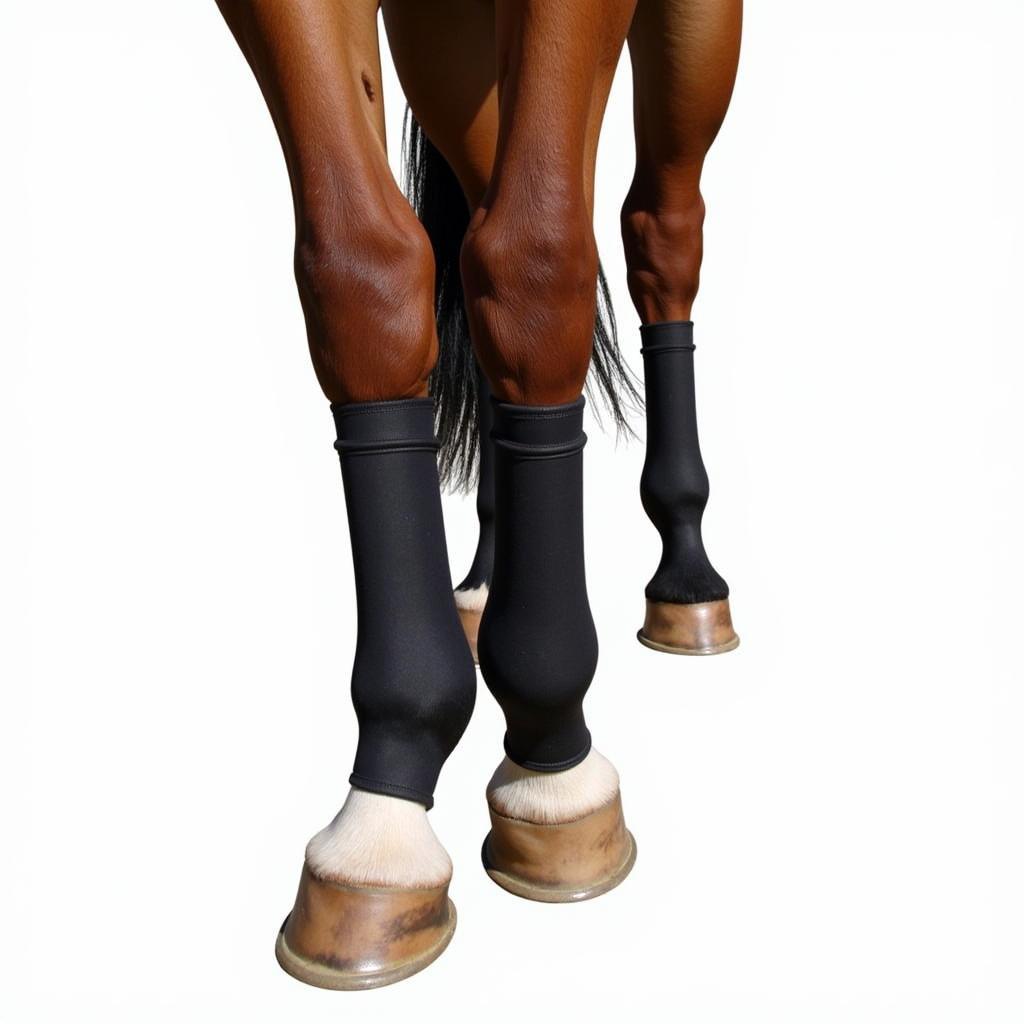Hock shields for horses are a valuable tool for horse owners looking to protect their equine companions from injury. Whether your horse is prone to brushing or you’re looking for preventative measures, understanding hock shields is essential.
What is a Hock Shield?
 Horse Wearing a Hock Shield
Horse Wearing a Hock Shield
A hock shield is a protective garment designed to safeguard a horse’s hock from impact and abrasion. These shields are typically made from durable, shock-absorbing materials like neoprene or gel and are fastened around the horse’s leg with Velcro or buckles.
Why Use Hock Shields for Horses?
Hock shields serve several important purposes, making them a worthwhile investment for many horse owners:
- Injury Prevention: The hock joint is particularly vulnerable to injury from brushing, especially during activities like trailering, turnout, or even in the stall. Hock shields provide a protective barrier, minimizing the risk of cuts, abrasions, and impact injuries.
- Support for Existing Injuries: If your horse has an existing hock injury, a hock shield can provide support and compression, promoting healing and reducing inflammation.
- Confidence Building: For horses that have experienced a past hock injury, wearing a hock shield can boost their confidence and encourage freer movement knowing they have added protection.
Types of Hock Shields
 Different Types of Hock Shields for Horses
Different Types of Hock Shields for Horses
There are several types of hock shields available, each with its own benefits:
- Neoprene Hock Wraps: These are the most common type, offering a snug fit and moderate protection.
- Gel Hock Boots: These shields utilize gel inserts for increased impact absorption and are ideal for horses needing extra support.
- Impact-Resistant Hock Shields: Constructed from rigid materials, these shields offer the highest level of protection, particularly during activities with a higher risk of impact.
Choosing the Right Hock Shield
Selecting the appropriate hock shield depends on several factors:
- Horse’s Needs: Consider your horse’s activity level, injury history, and any specific concerns you might have.
- Material: Neoprene is breathable and versatile, gel offers superior impact absorption, and rigid materials provide maximum protection.
- Fit: The hock shield should fit snugly without restricting movement or causing discomfort.
“It’s crucial to prioritize a proper fit when choosing a hock shield,” advises Dr. Emily Carter, equine veterinarian at Equine Wellness Center. “A poorly fitting shield can do more harm than good by rubbing or slipping, potentially exacerbating existing issues or creating new ones.”
How to Fit a Hock Shield Correctly
- Positioning: Ensure the hock shield is positioned correctly, covering the point of the hock and extending slightly above and below the joint.
- Fastening: Use the Velcro straps or buckles to secure the shield firmly but not too tightly.
- Check for Fit: After fastening, ensure you can comfortably fit two fingers between the shield and your horse’s leg. The shield should stay in place without rotating or slipping.
Caring for Your Horse’s Hock Shield
- Cleanliness: Regularly clean the hock shield according to the manufacturer’s instructions. This usually involves wiping it down with a damp cloth or using mild soap and water.
- Inspection: Inspect the shield regularly for any signs of wear and tear, such as loose stitching, cracks, or damage to the fasteners. Replace the shield if necessary.
Conclusion
Investing in a hock shield can provide valuable protection for your horse’s hocks, reducing the risk of injuries and promoting overall well-being. By understanding the different types, choosing the right fit, and caring for the shield properly, you can help keep your equine partner safe and sound for years to come.
FAQ
1. Can my horse wear hock shields all the time?
It’s generally not recommended to leave hock shields on 24/7. While beneficial during activity or turnout, prolonged use can trap heat and moisture, potentially leading to skin irritation.
2. What is the average lifespan of a hock shield?
The lifespan varies depending on the quality, frequency of use, and care. However, most hock shields last for several months to a year with proper maintenance.
3. Can I use a hock shield on a horse with an open wound?
No, you should never use a hock shield on an open wound. Consult with your veterinarian for appropriate wound care and protection.
4. Are hock shields only for performance horses?
Hock shields can be beneficial for horses of all disciplines and activity levels. Even horses used for pleasure riding or trail riding can benefit from the added protection.
5. My horse seems uncomfortable with the hock shield. What should I do?
Ensure the shield is fitted correctly and isn’t too tight. If the problem persists, consult with your veterinarian or an equine professional for assistance.
Still have questions?
Our team at Justus Horses USA is here to help! Contact us at 0772127271 or [email protected] for personalized advice on choosing the right hock shield for your horse. You can also visit our facility located at QGM2+WX2, Vị Trung, Vị Thuỷ, Hậu Giang, Việt Nam. Our dedicated customer care team is available 24/7 to address your concerns.